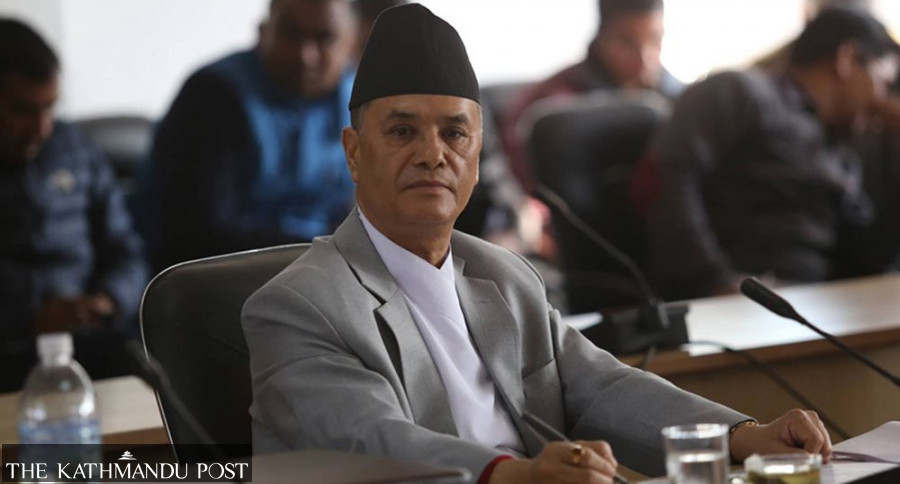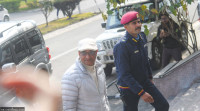National
Judicial deadlock looms large as chief justice and justices stick to their guns
Rana refuses to step down, saying he will rather face the constitutional process. He, however, says is ready to resign if other justices in question agree to do so too.
Tika R Pradhan
Amid a growing chorus of the resignation demand, Chief Justice Cholendra Shumsher Rana on Tuesday took a position that he would face Parliament rather than step down, raising the spectre of a judicial deadlock.
A section of lawyers has already decided to boycott the Supreme Court while justices are busy holding meetings, affecting hearings, just as there are thousands of cases pending.
During a meeting with 15 top court justices, Rana said that he is not going to step down just because of calls from the streets and in the media for him to resign.
“The chief justice told the justices that he would face the constitutional procedure and won’t step down,” said Baburam Dahal, spokesperson for the Supreme Court.
“If we start resigning on the basis of what people say on the streets, the judiciary cannot be saved,” Dahal quoted the chief justice telling his colleagues.
Justices Deepak Kumar Karki, Mira Khadka, Hari Krishna Karki, Bishowambhar Prasad Shrestha, Ananda Mohan Bhattarai, Prakash Man Singh Raut, Bam Kumar Shrestha, Tanka Bahadur Moktan, Prakash Kumar Dhungana, Sushma Lata Mathema, Kumar Regmi, Hari Prasad Phuyal, Manoj Kumar Sharma, Kumar Chudal and Nahakul Subedi were present at Tuesday’s meeting with Chief Justice Rana.
Four justices—Ishwar Khatiwada, Sapana Malla Pradhan, Anil Kumar Sinha and Tej Bahadur KC—were not present as they are out of Kathmandu.
Unless a chief justice resigns or dies, the post becomes vacant only if he or she is impeached.
As per constitutional provisions, one-fourth of the lawmakers can file an impeachment motion against a chief justice. But the motion must be endorsed by a two-thirds majority for the chief justice to be removed.
No chief justice in Nepal has been removed through impeachment. An impeachment motion was filed against then chief justice Sushila Karki in April 2017. But the motion was stayed by the Supreme Court in May that year.
A single bench led by Rana, who was then a justice, stayed the impeachment motion against Karki filed by lawmakers from the Nepali Congress and Communist Party of Nepal (Maoist Centre).
Rana was appointed chief justice in January 2019.
In Tuesday’s meeting, Rana also told the group of justices that he was ready to step down, provided that other justices who have come into question are also ready to do so.
According to a justice present in the meeting, the chief justice said he would go by the constitutional process if he has to step down, hinting at impeachment.
Since Nepal’s political parties have maintained silence on the ongoing controversy surrounding the judiciary, an impeachment motion in Parliament is unlikely.
The only party that has enough numbers to file an impeachment motion is KP Sharma Oli’ CPN-UML which has 97 members in the lower house. Oli on Tuesday said that his party was not going to get involved in the political maneuverings on the judiciary.
The Nepali Congress and the Maoist Centre have 61 and 49 members, respectively. Neither appears to be keen on moving an impeachment motion against Rana.
If Rana stands his ground—he may even go on leave—and justices and lawyers boycott the Supreme Court, members of the public will be the ultimate sufferers. That’s why there is a need to find a way out of this crisis in the judiciary at the earliest, according to a justice.
“We don’t want service seekers to suffer by our boycotting the benches but we stick to our conclusion that Rana must give a way out,” said the justice. “Others concerned [bar associations, civil society and political parties] also must come forward to extricate the judiciary from this crisis.”
Hearings have already been affected for two days since Monday, and going by the position the justices have taken, hearings are unlikely on Wednesday as well.
The 15 justices who met with Rana on Tuesday have decided to hold a meeting on Wednesday as well to “chart out” a strategy, as the chief justice has refused to clear the way, or resign for that matter.
Senior advocates have suggested that the Nepal Bar Association start boycotting the hearings and organize nationwide protests to pile pressure on Rana to resign.
“We won’t participate in hearings as long as Chief Justice Rana is there,” Shambhu Thapa, a senior advocate and former chair of the Nepal Bar Association, told reporters following the meeting with the Bar Association. “We have suggested that the Nepal Bar set up a team for a legal audit of controversial cases.”
After hours-long meetings following suggestions by dozens of its advisers and senior advocates that Rana should quit, the Nepal Bar Association later on Tuesday decided to ask the Chief Justice Rana to step down. It has also decided to launch nationwide protests if Rana refuses to resign.
“We have decided to protest against the chief justice if he doesn’t step down,” said Rakshya Basyal, vice-chair of the Nepal Bar Association. “We will first begin the struggle from the Supreme Court.”
The umbrella organisation of the lawyers across the country has also called for amending the constitution to ensure that there won’t be any interference from the executive, legislature and political parties in the judiciary.
Om Prakash Aryal, an advocate, said Rana needs to be ousted and his decisions reviewed.
Aryal is one of the petitioners who have challenged appointments to various constitutional bodies. Rana has not scheduled even a single hearing on those petitions for around 11 months now.
Erstwhile prime minister Oli in December last year had introduced an ordinance to amend the Constitutional Council Act. Provisions for holding Constitutional Council meetings and making recommendations were eased through the ordinance. As per the changed provisions, the council had held meetings and appointed as many as 52 individuals to different constitutional bodies. The meetings were held in the absence of House Speaker Agni Prasad Sapkota and Deuba, who was then the leader of the main opposition.
“The controversy this chief justice has courted are of immense proportions. He sought shares in constitutional bodies and the Council of Ministers,” Aryal told reporters after the meeting with the Bar Association. “No other justices have gone to that extent undermining the principle of separation of powers. There is no point in dragging other justices.”
The Rana-led Constitutional Bench, which consisted of four senior justices Karki, Khadka, Khatiwada and Bhattarai, on July 12, had ousted Oli as the prime minister and restored the House of Representatives that Oli had dissolved in May, for a second time. The bench had ordered that Congress leader Sher Bahadur Deuba be appointed prime minister.
Many believe Rana demanded a share in the Deuba Cabinet as part of the quid pro quo.
Days before Deuba expanded his Cabinet, reports surfaced that Gajendra Hamal was being appointed a minister at the behest of Rana. Deuba did appoint Hamal a minister on October 8, but the latter resigned within 40 hours after controversy.
Rana, however, has denied demanding ministerial positions for his people.
Justices say Hamal’s appointment is just the latest in a series of controversies Rana has been embroiled in. They have accused Rana of ignoring repeated calls to introduce reforms in the judiciary. A study panel led by Justice Hari Krishna Karki suggested that corruption was rife in the judiciary and that there was a need for an immediate intervention by the chief justice.
One of the suggestions by the study panel was to introduce the system of drawing lots to assign benches to justices. Though Rana had publicly said that he would introduce the system, he did not.
Legal experts say the judiciary is at its lowest ebb due to the failure of its leadership and therefore a quick solution must be sought.
“There is a chance of Nepal becoming a failed state and the international community may bar Nepali judges from participating in international functions,” said Balaram KC, a former Supreme Court justice. “There could be serious consequences of the ongoing confrontation.”
According to KC, the judiciary has not faced a crisis like this before, even though it has courted controversies once in a while in the past.
“The chief justice is by and large responsible for the current mess in the judiciary,” KC told the Post. “It will take a long time before the judiciary restores its image back. A solution must be sought at the earliest to the current crisis.”




 13.12°C Kathmandu
13.12°C Kathmandu













%20(1).jpg&w=300&height=200)

